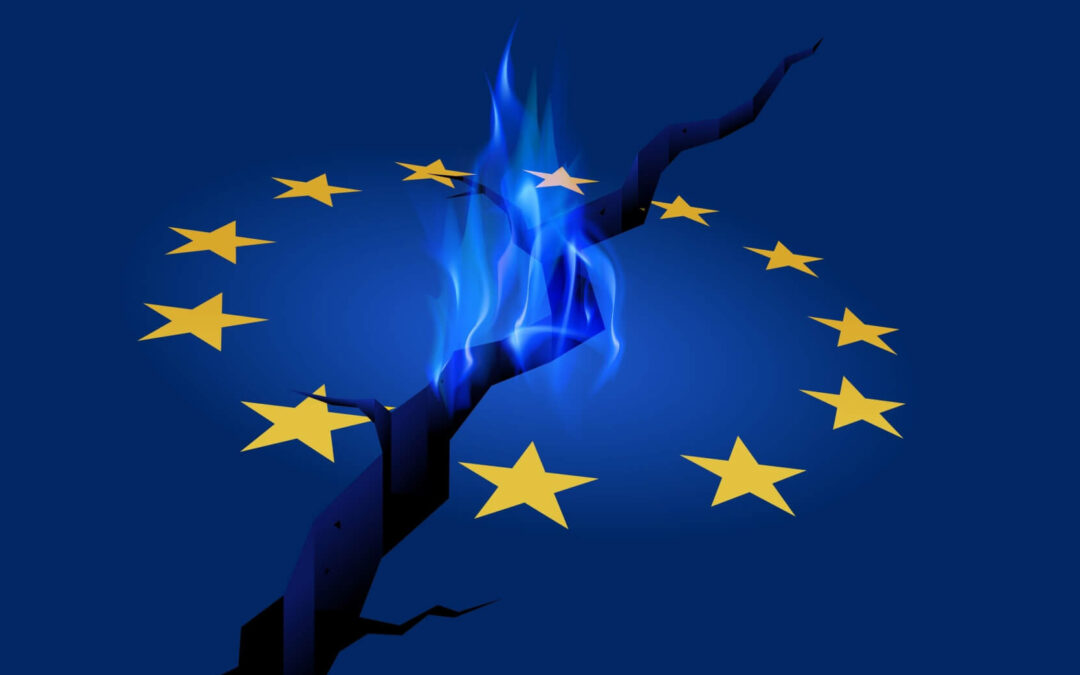Europe’s natural gas crisis shows we’re going to be dealing with the fallout of Russia’s invasion of Ukraine for years to come.
The global community condemned the initial invasion and levied sanctions… It even cut off valuable Russian oil and gas exports to Europe.
Sanctions have crippled the Russian economy, but they also affect your wallet at home.
Russia has been the European Union’s primary source of oil and gas for years.
But the sanctions cut 40% of the EU’s natural gas supply … in an instant.
That’s just the start as an EU energy crisis looks set to spill overseas to America.
Europe’s Reliance on Russian Energy
According to the European Commission, natural gas is about 25% of the EU’s total energy consumption.
Most natural gas is used in power generation (power plants use it to create heat):
The chart above shows the amount of natural gas consumed annually by the EU.
In 2021, EU nations used 396.6 billion cubic meters of natural gas — the highest amount since 2014, according to BP.
Russia accounted for nearly half of the natural gas used by the EU.
But now countries have to look elsewhere for this critical resource.
Natural Gas Demand Lifts Energy Prices Everywhere
The rules of supply and demand are simple:
- When demand is low, supply is up and prices are down.
- When demand is high, supply is low and prices are up.
Cutting off the EU’s Russian natural gas supply has created massive demand and higher prices:
As of August 2022, the monthly fuel price index (shown in the chart above) was the highest since before the COVID pandemic.
A mild start to the winter brought prices down in October, but they remain above pre-invasion levels.
This means the price of oil and gas around the world remains high … and the coldest winter months are still ahead.
EU Natural Gas Crisis Coming to U.S.
Like Europe, the U.S. uses natural gas as a primary source of power and heat.
Demand for natural gas in the summer and fall months is less due to milder temperatures, but demand rises the colder it gets.
On top of that, natural gas prices in the U.S. are already the highest they’ve been in nearly two decades:
As you can see in the chart above, Americans are paying 50% more for natural gas than they were even two years ago!
Because Europe is leaning into the U.S. for more gas, providers have to split their supply … leaving less for Americans.
This creates higher electricity bills:
Since 2019, the cost of electricity has increased for Americans.
Electric bills are 6.1% higher this year compared to 2021 — the largest yearly increase since 2006.
Next year, bills are expected to go up another 2.5%.
Bottom line: We have a situation where demand for natural gas is only going to grow in the coming months.
Prices are already rising during the EU's natural gas crisis.
I don’t think price increases on commodities related to power generation will cease any time soon.
Renewable energy is an answer … but not in the short term.
The transition from fossil fuels to renewables is underway, but it’s going to take longer than we might think to build out a complete infrastructure.
In the meantime, to position yourself for profit, I would look to American natural gas providers.
U.S. exports to Europe are only going to increase … along with demand here at home.
I encourage you to use our proprietary Stock Power Ratings system or read my Stock Power Daily to find the right plays and take advantage of this trend.
And if you’re looking for recommendations within the renewable energy mega trend, my colleague Adam O'Dell’s “Infinite Energy” presentation highlights the largest untapped energy source in the world.
This source is worth trillions of dollars and makes massive oil fields look tiny in comparison.
We’re still in the early stages, but this breakthrough is set to turn the global energy market on its head.
Make sure to watch his presentation for more information about this revolutionary new renewable tech (and the one company behind it all).
Safe trading,

Matt Clark, CMSA®
Research Analyst, Money & Markets
Matt Clark is the research analyst for Money & Markets. He is a certified Capital Markets & Securities Analyst with the Corporate Finance Institute and a contributor to Seeking Alpha. Before joining Money & Markets, he was a journalist/editor for 25 years, covering college sports, business and politics.





